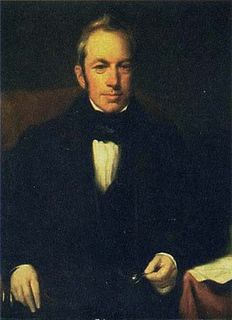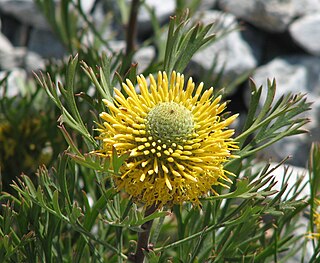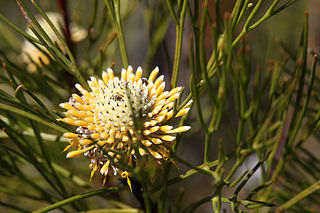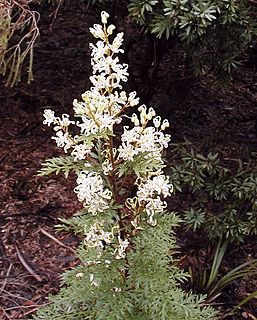
Robert Brown was a Scottish botanist and paleobotanist who made important contributions to botany largely through his pioneering use of the microscope. His contributions include one of the earliest detailed descriptions of the cell nucleus and cytoplasmic streaming; the observation of Brownian motion; early work on plant pollination and fertilisation, including being the first to recognise the fundamental difference between gymnosperms and angiosperms; and some of the earliest studies in palynology. He also made numerous contributions to plant taxonomy, notably erecting a number of plant families that are still accepted today; and numerous Australian plant genera and species, the fruit of his exploration of that continent with Matthew Flinders.

Richard Anthony Salisbury, FRS was a British botanist. While he carried out valuable work in horticultural and botanical sciences, several bitter disputes caused him to be ostracised by his contemporaries.

Grevillea, commonly known as spider flowers, is a genus of about 360 species of evergreen flowering plants in the family Proteaceae. Plants in the genus Grevillea are shrubs, rarely trees, with the leaves arranged alternately along the branches, the flowers zygomorphic, arranged in racemes at the ends of branchlets, and the fruit a follicle that splits down one side only, releasing one or two seeds.

Banksia sessilis, commonly known as parrot bush, is a species of shrub or tree in the plant genus Banksia of the family Proteaceae. It had been known as Dryandra sessilis until 2007, when the genus Dryandra was sunk into Banksia. The Noongar peoples know the plant as budjan or butyak. Widespread throughout southwest Western Australia, it is found on sandy soils over laterite or limestone, often as an understorey plant in open forest, woodland or shrubland. Encountered as a shrub or small tree up to 6 m (20 ft) in height, it has prickly dark green leaves and dome-shaped cream-yellow flowerheads. Flowering from winter through to late spring, it provides a key source of food—both the nectar and the insects it attracts—for honeyeaters in the cooler months, and species diversity is reduced in areas where there is little or no parrot bush occurring. Several species of honeyeater, some species of native bee, and the European honey bee seek out and consume the nectar, while the long-billed black cockatoo and Australian ringneck eat the seed. The life cycle of Banksia sessilis is adapted to regular bushfires. Killed by fire and regenerating by seed afterwards, each shrub generally produces many flowerheads and a massive amount of seed. It can recolonise disturbed areas, and may grow in thickets.

Isopogon anemonifolius, commonly known as broad-leaved drumsticks, is a shrub of the family Proteaceae that is native only to eastern New South Wales in Australia. It occurs naturally in woodland, open forest, and heathland on sandstone soils. I. anemonifolius usually ranges between one and two metres in height, and is generally smaller in exposed heathland. Its leaves are divided and narrow, though broader than those of the related Isopogon anethifolius, and have a purplish tinge during the cooler months. The yellow flowers appear during late spring or early summer and are displayed prominently. They are followed by round grey cones, which give the plant its common name drumsticks. The small hairy seeds are found in the old flower parts.

Isopogon anethifolius, commonly known as narrow-leaf drumsticks or narrow-leafed drumsticks, is a shrub in the family Proteaceae. The species is found only in coastal areas near Sydney in New South Wales, and to the immediate west. It occurs naturally in woodland, open forest and heathland on sandstone soils. An upright shrub, it can reach to 3 m (9.8 ft) in height, with terete leaves that are divided and narrow. The yellow flowers appear in the Spring, from September to December, and are prominently displayed. They are followed by round grey cones, which give the plant its common name of drumsticks. The small hairy seeds are found in the old flower parts.

Grevillea mucronulata, also known as green spider flower or green grevillea, is a species of flowering plant of the family Proteaceae and is endemic to New South Wales in Australia. Described by Robert Brown in 1810, it is found in open sclerophyll forest or woodland around the Sydney region and New South Wales south coast. It grows as a small bush to 3 m (9.8 ft) high and wide, with variable foliage and greenish flowers that appear over the cooler months from May to October. The flowers are attractive to birds.
Joseph Knight, gardener to George Hibbert, was one of the first people in England to successfully propagate Proteaceae. He is remembered as the nominal author of a publication that caused one of the biggest controversies of 19th-century English botany.

On the cultivation of the plants belonging to the natural order of Proteeae is an 1809 paper on the family Proteaceae of flowering plants. Although nominally written by Joseph Knight as a paper on cultivation techniques, all but 13 pages consists of an unattributed taxonomic revision now known to have been written by Richard Salisbury.

Proteoideae is one of five subfamilies of the flowering plant family Proteaceae. The greatest diversity of Proteoideae is in Africa, but there are also many species in Australia; a few species occur in South America, New Caledonia, and elsewhere.

Isopogon ceratophyllus, commonly known as the horny cone-bush or wild Irishman, is a plant of the family Proteaceae that is endemic to the coast in Victoria, South Australia and on the Furneaux Group of islands in Tasmania. It is a small woody shrub that grows to 100 cm high with prickly foliage. It is extremely sensitive to dieback from the pathogen Phytophthora cinnamomi

Observations, systematical and geographical, on the herbarium collected by Professor Christian Smith, in the vicinity of the Congo, during the expedition to explore that river, under the command of Captain Tuckey, in the year 1816, also published as Observations, systematical and geographical, on Professor Christian Smith's collection of plants from the vicinity of the River Congo, is an 1818 paper written by Robert Brown on the botany of tropical Africa. It is significant for its contributions to plant systematics, and to African floristics and phytogeography.

Telopea truncata, commonly known as the Tasmanian waratah, is a plant in the family Proteaceae. It is endemic to Tasmania where it is found on moist acidic soils at altitudes of 600 to 1200 m (2000–4000 ft). Telopea truncata is a component of alpine eucalypt forest, rainforest and scrub communities. It grows as a multistemmed shrub to a height of 3 metres (10 ft), or occasionally as a small tree to 10 m (35 ft) high, with red flower heads, known as inflorescences, appearing over the Tasmanian summer and bearing 10 to 35 individual flowers. Yellow-flowered forms are occasionally seen, but do not form a population distinct from the rest of the species.

Persoonia laurina, commonly known as the laurel-leaved or laurel geebung, is a shrub of the family Proteaceae native to central New South Wales in eastern Australia. Found in sclerophyll forest, it grows to a height of 2 metres. The yellow flowers appear in late spring.

Lomatia silaifolia, commonly known as crinkle bush or parsley fern, is a plant of the family, Proteaceae native to eastern Australia. Naturally found in open forest, it grows as a small shrub 1–2 m high with highly pinnate leaves reminiscent of parsley. The white inflorescences appear in summer.

Synaphea spinulosa is a species of small shrub in the flowering plant family Proteaceae. It is endemic to Western Australia. Together with Acacia truncata, it was the first Australian endemic to be scientifically described and named, and the specimen upon which that description is based is the oldest extant specimen of an Australian plant, and very likely among the first Australian plant specimens ever collected.

Leucospermum oleifolium is an erect shrub of about 1 m (3.3 ft) high and 1½ m (5 ft) across that is assigned to the family Proteaceae. It has spreading branches, densely set with initially felty, entire, oval, olive-colored leaves of about 3½ cm long and 1½ cm (0.6 in) wide, with a bony tip that sometimes has two to five blunt teeth, with a blunt base and conspicuous veins. The flowers and their long thread-like styles are initially sulfur yellow, but soon become orange and finally turn brilliant crimson. The flower heads are about 4 cm (1.6 in) in diameter, crowded at the tip of the branches with a maximum of five that start flowering in turn. This provides for a colour spectacle from August till December. It is called by various names in South Africa such as Overberg pincushion, flame pincushion, mix pincushion and tuft pincushion. It naturally occurs in fynbos in the Western Cape province of South Africa.

Leucospermum saxatile is an evergreen, rising to sprawling shrub of ½–¾ m high and 1–1½ m (3⅓–5 ft) wide, from the family Proteaceae. It has reddish tinged flowering stems and line-shaped, narrowing wedge-shaped leaves of 2½–5 cm(1–2 in) long and 2–5 mm (0.08–0.20 in) wide, with one to three blunt teeth, whorl-shaped, flat-topped, at first pale lime green but later carmine flower heads of 2½–3 cm across, mostly individually but sometimes grouped with two or three, each on a stalk. The flower heads occur from July to October. From the flowers occur long styles with a slightly thicker tip, which together give the impression of a pincushion. It is called Karoo pincushion in English. Flowering heads can be found from July until February. It naturally occurs in fynbos in the Western Cape province of South Africa.

Isopogon longifolius is a small shrub in the family Proteaceae that is endemic to the southwest of Western Australia.

Protea canaliculata, also known as the groove-leaf sugarbush, is a species of flowering shrub of the genus Protea, which is endemic to the Cape Provinces of South Africa.




















